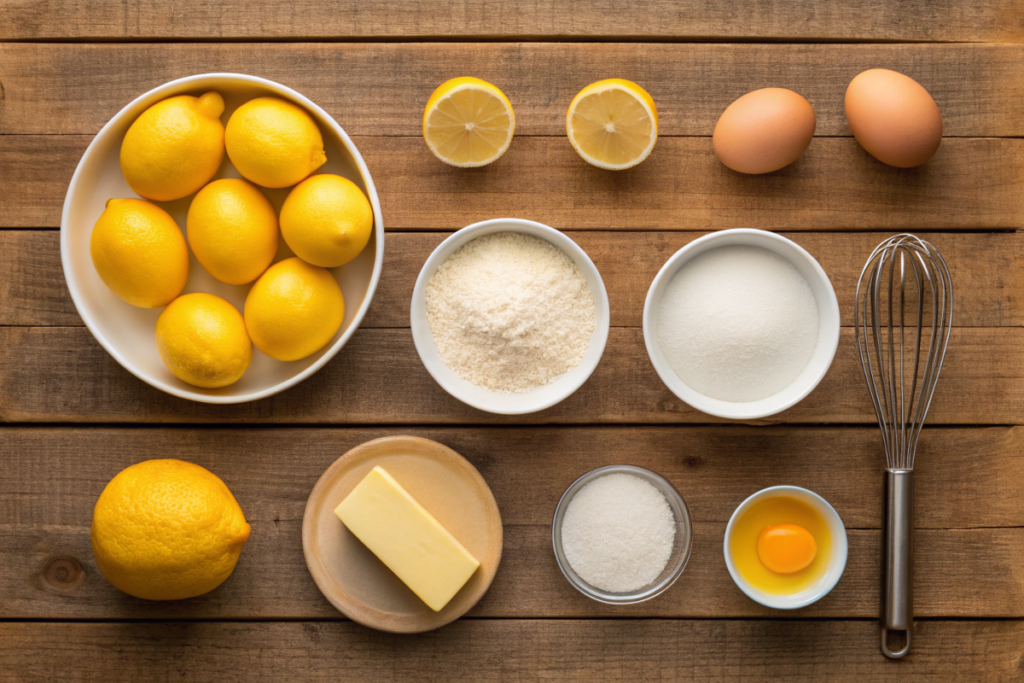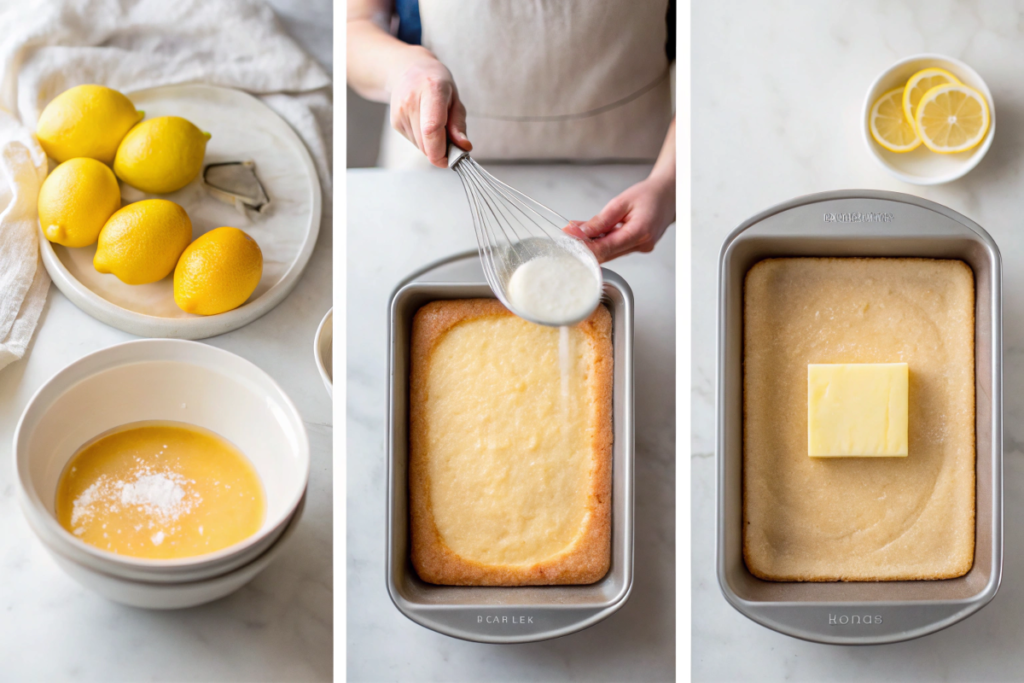Baking a lemon drizzle cake is a delightful endeavor, but encountering cracks can be frustrating. Why Has My Lemon Drizzle Cake Cracked? Understanding the common reasons behind cracked cakes is essential for achieving flawless results. For more inspiration, check out 20 Types of Dessert to expand your baking repertoire.
In this comprehensive guide, we will explore the cracks in lemon drizzle cake, uncover the underlying causes, and provide practical solutions to prevent and fix these issues. Whether you’re a seasoned baker or a novice in the kitchen, this article will help you bake the perfect lemon drizzle cake every time.
Moreover, we will delve into the science of cake baking, examine the factors that contribute to cracked cakes, and offer expert tips for maintaining the integrity of your lemon drizzle creations.
By the end of this guide, you’ll have a thorough understanding of how to avoid and address cracks in your cakes, ensuring they remain as beautiful as they are delicious.
Understanding the Science Behind Cake Baking
How Heat Affects Cake Structure
Heat plays a crucial role in cake baking, influencing the structure and texture of your lemon drizzle cake. How heat affects cake structure involves the transformation of batter into a fluffy, airy sponge through the expansion of air bubbles and the setting of proteins and starches.
Proper heat distribution ensures that the cake rises evenly without creating weak points that can lead to cracks.
The Role of Ingredients in Cake Stability
The ingredients you use are fundamental to the stability of your cake. The role of ingredients in cake stability includes the balance of fats, sugars, and leavening agents.
For instance, butter contributes to the cake’s moisture and tenderness, while caster sugar helps in aeration. The right proportions and quality of ingredients prevent excessive moisture loss, which can cause cracks in lemon drizzle cakes.
Importance of Oven Temperature Control
Maintaining the correct oven temperature is vital for preventing cracked cakes. Importance of oven temperature control ensures that the cake bakes evenly and rises uniformly.
An oven that is too hot can cause the cake to rise rapidly, creating cracks on the surface as the interior struggles to set properly. Using an oven thermometer can help you monitor and adjust the temperature for optimal baking results.
Common Reasons Why Lemon Drizzle Cakes Crack
Overmixing the Batter
Overmixing the batter can lead to a dense and heavy cake by excessively developing the gluten in the flour, resulting in a tough texture and increasing the likelihood of cracks. To avoid cracks in lemon drizzle cakes, gently fold the dry ingredients into the wet mixture until just combined.
Incorrect Oven Temperature
Baking at an incorrect temperature is a frequent cause of cracked cakes. Incorrect oven temperature can make the cake rise unevenly, leading to cracks on the surface. Ensure your oven is preheated to the recommended temperature and use a reliable oven thermometer to maintain consistency.
Using the Wrong Size of Baking Tin
Using a baking tin that is either too small or too large can disrupt the baking process, causing the cake to overflow or bake too quickly, which often results in cracks. Selecting the appropriate size of baking tin is crucial for achieving a smooth, crack-free surface.
Uneven Heat Distribution in the Oven
Uneven heat distribution can cause parts of the cake to bake faster than others, leading to cracks. This creates hot spots that make the cake rise unevenly. Rotating the cake halfway through baking can help promote even cooking and prevent cracks.
Avoiding Cracks: Baking the Perfect Lemon Drizzle Cake
Measuring Ingredients Accurately
Accurate measurement of ingredients is essential for cake stability. Measuring ingredients accurately ensures that the right balance of fats, sugars, and leavening agents is maintained. Use a kitchen scale for precise measurements to avoid discrepancies that can lead to cracked sponge cakes.
Preparing Your Baking Tin Properly
Proper preparation of your baking tin helps prevent cracks in lemon drizzle cakes. Preparing your baking tin properly includes greasing and lining the tin with baking parchment to facilitate easy removal and even baking. This step ensures that the cake retains its shape and rises evenly.
Adjusting Baking Time for Different Ovens
Different ovens can have varying temperatures and heat distribution patterns. Adjusting baking time for different ovens involves monitoring the cake closely and making necessary adjustments to the baking duration. Start checking for doneness a few minutes before the recommended time to prevent overbaking and cracking.
Using a Baking Thermometer for Precision
A baking thermometer provides an accurate measurement of your oven’s temperature. Using a baking thermometer for precision helps maintain the correct baking temperature, ensuring that your lemon drizzle cake bakes evenly and minimizes the risk of cracks.
How to Fix a Cracked Lemon Drizzle Cake
Repairing the Surface with Lemon Glaze
If your lemon drizzle cake develops cracks, you can repair the surface with an additional lemon glaze. How to fix a cracked lemon drizzle cake involves gently brushing the cracked areas with a thin layer of lemon glaze, which can help mask the imperfections and add extra flavor.
Creating Decorative Toppings to Cover Cracks
Decorative toppings can effectively hide cracks while enhancing the cake’s appearance. Creating decorative toppings to cover cracks includes using fresh berries, powdered sugar, or edible flowers to distract from any visible imperfections and add an aesthetic touch.
Repurposing the Cake into Smaller Treats
A cracked lemon drizzle cake can be transformed into smaller, bite-sized treats. Repurposing the cake into smaller treats involves cutting the cake into individual servings, such as truffles or mini tarts, which can be a creative way to enjoy a flawed cake without wasting any of it.
Step-by-Step Guide to Baking a Lemon Drizzle Cake Without Cracks
Choosing the Right Ingredients
Selecting high-quality ingredients is the foundation of a flawless lemon drizzle cake. Choosing the right ingredients includes using fresh lemons, premium butter, and fine caster sugar to ensure optimal flavor and texture.
Mixing Techniques for a Smooth Batter
Proper mixing techniques help prevent cracks in lemon drizzle cakes. Mixing techniques for a smooth batter involve creaming the butter and sugar thoroughly, adding eggs one at a time, and folding in the dry ingredients gently to maintain an airy batter.
Baking at the Correct Temperature
Maintaining the correct baking temperature is crucial for avoiding cracks. Baking at the correct temperature ensures that the cake rises evenly and sets properly without forming cracks on the surface.
Cooling the Cake to Prevent Collapse
Allowing the cake to cool properly helps prevent cracks from forming as it sets. Cooling the cake to prevent collapse involves letting the cake cool in the tin for a few minutes before transferring it to a wire rack to cool completely.

The Role of Lemon Drizzle in Cake Cracks
When to Apply the Drizzle for Best Results
Timing is key when applying lemon drizzle to your cake. When to apply the drizzle for best results involves pouring the lemon syrup over the cake while it is still warm, allowing the syrup to soak in and add moisture without compromising the cake’s structure.
How Lemon Juice and Sugar Interact During Baking
The interaction between lemon juice and sugar affects the cake’s texture and stability. How lemon juice and sugar interact during baking involves the sugar absorbing the lemon juice, which helps to keep the cake moist and reduces the likelihood of cracks forming as the cake cools.
Avoiding Over-Saturation of the Cake
Over-saturating the cake with syrup can lead to structural weaknesses. Avoiding over-saturation of the cake involves applying the right amount of drizzle to maintain moisture without making the cake soggy, which can cause cracks.
Expert Tips for Perfect Lemon Drizzle Cakes Every Time
Balancing Ingredients for Texture and Moisture
Achieving the right balance of ingredients is key to a perfect lemon drizzle cake. Balancing ingredients for texture and moisture involves using the correct proportions of butter, sugar, and liquid to maintain a moist and tender crumb without making the cake too dense.
Preheating the Oven Correctly
Proper oven preheating is essential for even baking. Preheating the oven correctly ensures that your lemon drizzle cake starts baking at the right temperature from the moment it goes in, promoting even rise and reducing the risk of cracks.
Checking the Cake’s Doneness Without Opening the Oven
To prevent temperature fluctuations, it’s important to check your cake’s doneness without frequently opening the oven. Checking the cake’s doneness without opening the oven can be done using a toothpick inserted into the center. If it comes out clean, the cake is done.

Recipes to Try After Mastering Lemon Drizzle Cake
Lemon and Poppy Seed Loaf
Expand your baking repertoire with a Lemon and Poppy Seed Loaf. This moist and flavorful loaf combines the zesty brightness of lemons with the subtle crunch of poppy seeds, making it a delightful treat for any time of day.
Orange Drizzle Cake for a Twist
For a variation on the classic lemon drizzle cake, try an Orange Drizzle Cake. This version offers a unique citrus flavor, pairing the sweetness of orange with a tangy glaze that adds a refreshing twist to your baking.
Gluten-Free Lemon Cake Recipe
Enjoy the same great taste with a gluten-free twist. This Gluten-Free Lemon Cake Recipe uses alternative flours to create a light and airy cake that’s perfect for those with gluten sensitivities, without compromising on flavor or texture.
Frequently Asked Questions About Lemon Drizzle Cake Cracks
Can I still eat a cracked lemon drizzle cake?
Yes, you can still enjoy a cracked lemon drizzle cake. Can I still eat a cracked lemon drizzle cake? The cracks do not affect the taste or safety of the cake, although they may impact its appearance. The cake remains delicious and can be enjoyed as intended.
How do I prevent cracks when baking other cakes?
Preventing cracks in other cakes follows similar principles. How to avoid cracks in sponge cakes includes accurate ingredient measurements, proper mixing techniques, and maintaining the correct baking temperature.
Does adding more liquid help prevent cracks?
Adding more liquid can sometimes help maintain moisture, but it is not always a solution for preventing cracks. Cake cracks: causes and fixes are typically related to structural issues rather than moisture levels alone.
Is a cracked cake a sign of overbaking?
Yes, a cracked cake can be a sign of overbaking. Is a cracked cake a sign of overbaking? Overbaking can cause the cake to dry out and crack as it cools, so monitoring the baking time closely is essential.
Can I use foil to prevent cracks?
Using foil can help regulate the baking temperature and prevent the cake from browning too quickly. Can I use foil to prevent cracks? Covering the cake loosely with aluminum foil if it is browning too fast can help prevent cracks.
Conclusion
In summary, Why Has My Lemon Drizzle Cake Cracked? is a common baking issue that can be addressed by understanding the science behind cake baking, using the right ingredients, and following proper techniques. Key takeaways for crack-free baking include accurate measurements, proper oven temperature control, and gentle mixing techniques to maintain a smooth batter.

